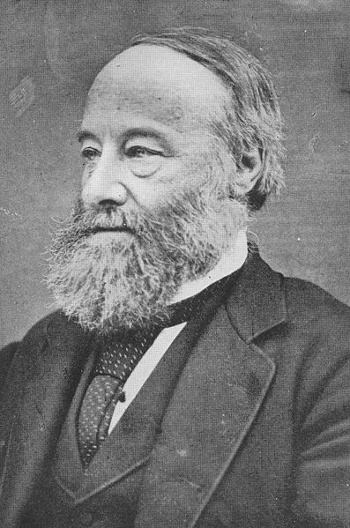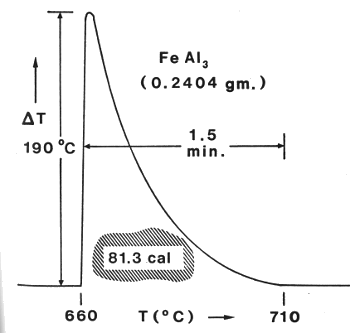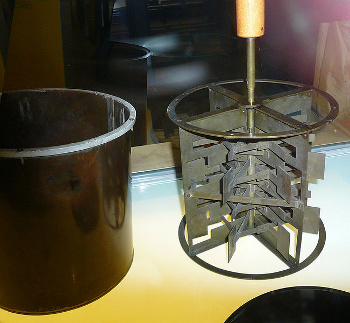James Prescott Joule
June 14, 2012
My
household has a plethora of
electrical gadgets that do
mechanical work so my wife and I don't need to. In the
kitchen, we have a
mixer,
food processor,
dishwasher, and a
coffee grinder. We have a
pump for our
water well, and a
circulator pump for our
gas-fired boiler. We have a
clothes washer and
dryer; and, in the
garage, we have a
garage door opener. I confess that I was too lazy to install the garage door opener, which is still in the box, but, some day...
We don't have an
electric vehicle, but I see a time when the
internal combustion engine will be extinct, at least for
passenger vehicles. All these devices have
electric motors that convert
electrical energy into
mechanical energy.
Energy may take different forms, but we now realize that it's all the same thing. The unit of energy is the
joule.
In mechanical terms, a joule is the energy required to apply a
force of one
newton through a
meter's distance; that is, it's a newton-meter (N⋅m). In electrical terms, it's the energy expended when a
current of one
ampere is passed through a one
ohm resistor for one
second. The joule is named after
James Prescott Joule (1818-1889), an
English physicist who is best known for determining the
mechanical equivalent of heat.

James Prescott Joule (1818-1889).
This photograph is from the book, Britain's Heritage of Science, by Arthur Shuster and Arthur E. Shipley (London, 1917).
(Via Wikimedia Commons))
The electrical equivalent of heat is known as
Joule's law, which is essentially the equation,
Q = I2 ⋅ R ⋅ t,
in which
Q is the heat generated (joules) in the resistor
R (ohms) by a current
I (amperes) flowing for a time
t (seconds).
Calorimeters are devices that are used to measure heat. Every calorimeter has its own "personality," so each needs its own
calibration. One way to do this is to perform a known
chemical reaction and measure its heat. A lot of
benzoic acid (C
7H
6O
2) has been
burned for this purpose, since this is an easy way to generate heat.
C7H6O2(s) + 7.5 O2(g) -> 7CO2(g) + 3H2O(l) ΔH = 3,227 kJ
Since my calorimeters were not designed to
combust benzoic acid, Joule's law was very important to me for my
thermodynamic studies. I would use an electrical current to heat a resistor inside the calorimeter, thereby releasing a known quantity of heat.

Old data never dies, it just becomes fodder for blog articles.
This data trace from a differential scanning calorimeter (DSC) is from an experiment I did about thirty-five years ago. It shows the evolution of heat from the formation of the iron-aluminum intermetallic compound, FeAl3)
Joule studied for a time under
John Dalton, a leading
chemist of his time, before taking over management of the family
brew works. Since
science was his principal
avocation, Joule conducted some
experiments at the brewery, one of which is the determination of the
efficiency of electrical motors, as compared with that of
steam engines. It was in these experiments that Joule conceived of the idea of using a
foot-pound, the ability to lift a pound's weight one foot against
gravity, as his unit.[1]
In a short
abstract, dated December 18, 1840, but surprisingly appearing in the 1837 issue of the
Proceedings of the Royal Society,[3] Joule announced the electrical equivalent of heat by equating the heat of reaction in an
electrochemical cell with that of the heat generated by a current flowing through a resistance. This resulted in his formulation of Joule's law.
Subsequently, in a paper read before a meeting of the
British Association meeting in
Cambridge, Joule expressed his idea of the
mechanical equivalent of heat:[1]
"... The motive power of the electro-magnetic engine is obtained at the expense of the heat due to the chemical reactions of the battery by which it is worked."
The mechanical equivalent of heat, relating the quantity of mechanical work to heat, is probably Joule's most important discovery.
Benjamin Thompson, a.k.a., Count Rumford, had done some
qualitative experiments around 1797 in which he applied the
friction of a blunt
boring tool to a
cannon barrel in
water. He found that the water
boiled after about two and a half hours.[2]
Joule quantified this effect using an apparatus that stirred water in a vessel using the energy obtained in the drop of weights working a
pulley system (see photograph). The friction involved in this process heated the water, and the
temperature rise gave the measure of the heat evolved.[1]

James P. Joule's apparatus for the measurement of the mechanical equivalent of heat, now housed in the Science Museum, London.
(Photo by Dr. Mirko Junge, via Wikimedia Commons))
Joule's careful experiments demonstrated that the various forms of energy are identical, and they can be changed from one form to another. This is
conservation of energy, which is the
first law of thermodynamics.[1]
I'll close this article with a quotation by Benjamin Thompson (Count of Rumford). Although its subject is heat, his advice can be applied to any scientific pursuit.
"But, although the mechanism of heat should, in fact, be one of those mysteries of nature which are beyond the reach of human intelligence, this ought by no means to discourage us, or even lessen our ardour, in our attempts to investigate the laws of its operations."[4]
References:
- December 1840: Joule's abstract on converting mechanical power into heat, APS News, vol. 18, no. 11 (December, 2009), p. 2.
- Benjamin Count of Rumford, "An Experimental Enquiry Concerning the Source of the Heat which is Excited by Friction", Philosophical Transaction of the Royal Society, vol. 88 (January 1, 1798), pp. 80-102.
- J. P. Joule, "On the Production of Heat by Voltaic Electricity," Proc. R. Soc. Lond., 1837, no. 4, pp. 280-282.
- Benjamin Count of Rumford, "An Experimental Enquiry Concerning the Source of the Heat which is Excited by Friction", Philosophical Transaction of the Royal Society, vol. 88 (January 1, 1798), p. 100.
- The scientific papers of James Prescott Joule (1884), archive.org, available in many electronic formats.
Permanent Link to this article
Linked Keywords: Household; electricity; electrical; mechanical work; kitchen; mixer; food processor; dishwasher; coffee grinder; pump; water well; circulator pump; natural gas; gas-fired boiler; clothes washer; clothes dryer; garage; garage door opener; electric vehicle; internal combustion engine; automobile; passenger vehicle; electric motor; electrical energy; mechanical energy; energy; joule; force; newton; meter; current; ampere; ohm; resistor; second; James Prescott Joule; English; physicist; mechanical equivalent of heat; Britain's Heritage of Science, by Arthur Shuster and Arthur E. Shipley (London, 1917); Wikimedia Commons; Joule's law; calorimeter; calibration; chemical reaction; benzoic acid; burn; combust; thermodynamics; thermodynamic; differential scanning calorimeter; iron; aluminum; intermetallic compound; John Dalton; chemist; brewery; brew works; science; avocation; experiment; efficient energy use; efficiency; steam engine; foot-pound; gravity; abstract; Proceedings of the Royal Society; electrochemical cell; British Association; Cambridge; Benjamin Thompson; An Experimental Enquiry Concerning the Source of the Heat which is Excited by Friction; friction; boring tool; cannon barrel; water; boil; pulley system; temperature; Science Museum, London; Dr. Mirko Junge; conservation of energy; first law of thermodynamics.